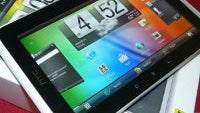HTC Flyer Unboxing

Regarded as one of the premier titans in the smartphone industry, it’s almost hard to imagine not seeing HTC joining the foray that’s easily surrounding the highly competitive tablet market right now, but chiming in at the nick of time, the HTC Flyer is finally here giving the Taiwan based company their offering. Although it can be seen as a late venture, especially when you factor in the wealth of tablets out there now, the Flyer is trying to differentiate itself from the pack by attempting to bring back an accessory once perceived to be a must-have with touchscreens – the stylus.
Being a 7” tablet and all, we’re presented with a much more compact looking white packaging that’s relatively light with branding around its sides, but of course, an accurate sized image of the tablet is tastefully displayed right in front for all to see – thus giving the consumer a good idea of what to expect with its size. Flipping it over to its back, useful information such as its highlights and specifications are displayed to really place emphasis on what’s so great with it. However, opening up the box, we don’t find anything out of the ordinary that we’d commonly expect nowadays – like its usual set of documentation, wall charger, and microUSB cable.
For starters, the first thing to come to mind holding the HTC Flyer Wi-Fi is that it bears a resemblance to devices like the HTC Desire HD and Inspire 4G – mainly because of its unibody aluminum construction. Obviously, the high quality materials in use with it surely supplement its overall solid construction, however, it does make the tablet slightly on the heavy side. Regardless, we’re quite pleased thus far with it, and even more when most other 7-inch tablets we’ve seen are made out of plastic more than anything.
Even though the HTC Flyer is packing a single core 1.5GHz Snapdragon processor, as opposed to the dual-core tablets we’ve been seeing of late, it still manages to run smoothly in the short time of us handling it. Some of its other features include a 7” display with a resolution of 1,024 x 600, 1GB RAM, 5-megapixel rear camera, 1.3-megapixel front-facing camera, aGPS, Bluetooth 3.0, 802.11 b/g/n Wi-Fi, microUSB port, and a microSD card slot. Despite not offering the tablet-optimized experience with Android 3.0 Honeycomb, the HTC Flyer is able to spruce things up with its latest version of Sense running on top of Android 2.3 Gingerbread. Moreover, it differentiates itself from most other tablets with its HTC Scribe technology – one that intricately makes use of an optional stylus.
For starters, the first thing to come to mind holding the HTC Flyer Wi-Fi is that it bears a resemblance to devices like the HTC Desire HD and Inspire 4G – mainly because of its unibody aluminum construction. Obviously, the high quality materials in use with it surely supplement its overall solid construction, however, it does make the tablet slightly on the heavy side. Regardless, we’re quite pleased thus far with it, and even more when most other 7-inch tablets we’ve seen are made out of plastic more than anything.
Even though the HTC Flyer is packing a single core 1.5GHz Snapdragon processor, as opposed to the dual-core tablets we’ve been seeing of late, it still manages to run smoothly in the short time of us handling it. Some of its other features include a 7” display with a resolution of 1,024 x 600, 1GB RAM, 5-megapixel rear camera, 1.3-megapixel front-facing camera, aGPS, Bluetooth 3.0, 802.11 b/g/n Wi-Fi, microUSB port, and a microSD card slot. Despite not offering the tablet-optimized experience with Android 3.0 Honeycomb, the HTC Flyer is able to spruce things up with its latest version of Sense running on top of Android 2.3 Gingerbread. Moreover, it differentiates itself from most other tablets with its HTC Scribe technology – one that intricately makes use of an optional stylus.
Of course, we’ll be checking out what the HTC Flyer has to offer, but considering that it’s coming out of the gate with Gingerbread on board, as opposed to Honeycomb, we’ll see if its customized interface combined with Scribe technology can really still give us a decent table experience. Expect our in-depth review soon!









Things that are NOT allowed: